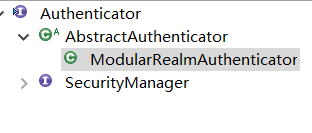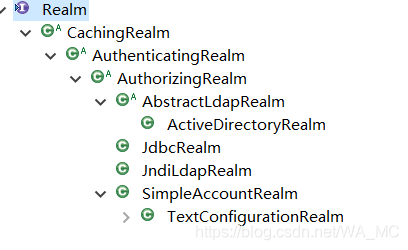ini
[main]
userRealm=cn.wit.realm.UserRealm
securityManager.realm=$userRealm
根据taken拿到username,然后用username查询数据库,返回User
对象信息,赋值username和password,SimpleAuthenticationInfo对象 传入username、password、realm名称(父类提供了getName方法,重写这个方法),然后返回这个info对象。表示将数据库的用户信息给shiro,shiro会去比较登录的信息(taken里边的),如果一致就登录成功
UserRealm extends AuthorizingRealm
package cn.wit.realm;
import java.beans.PropertyVetoException;
import java.sql.ResultSet;
import java.sql.SQLException;
import org.apache.shiro.authc.AuthenticationException;
import org.apache.shiro.authc.AuthenticationInfo;
import org.apache.shiro.authc.AuthenticationToken;
import org.apache.shiro.authc.SimpleAuthenticationInfo;
import org.apache.shiro.authz.AuthorizationInfo;
import org.apache.shiro.realm.AuthorizingRealm;
import org.apache.shiro.subject.PrincipalCollection;
import cn.wit.users.Users;
import com.mchange.v2.c3p0.ComboPooledDataSource;
import java.sql.Connection;
import java.sql.PreparedStatement;
public class UserRealm extends AuthorizingRealm{
@Override
public String getName() {
// TODO Auto-generated method stub
return "uesrRealm";
}
@Override
protected AuthorizationInfo doGetAuthorizationInfo(PrincipalCollection arg0) {
return null;
}
@Override
protected AuthenticationInfo doGetAuthenticationInfo(
AuthenticationToken taken) throws AuthenticationException {
String username=(String) taken.getPrincipal();
String pwd="";
Connection conn=null;
PreparedStatement ps=null;
ResultSet rs=null;
ComboPooledDataSource cpds=null;
try {
//c3p0获取数据库连接conn
cpds= new ComboPooledDataSource();
cpds.setDriverClass("com.mysql.jdbc.Driver");
cpds.setJdbcUrl("jdbc:mysql://localhost:3306/login");
cpds.setUser("root");
cpds.setPassword("wityy");
conn = cpds.getConnection();
String sql="select *from users where username=?";
ps= conn.prepareStatement(sql);
ps.setObject(1,username);
rs=ps.executeQuery();
while(rs.next()){
Users users=new Users();
users.setId(rs.getInt("id"));
users.setUsername(rs.getString("username"));
users.setPassword(rs.getString("password"));
pwd=users.getPassword();
username=users.getUsername();
}
} catch (SQLException e) {
e.printStackTrace();
} catch (PropertyVetoException e) {
// TODO Auto-generated catch block
e.printStackTrace();
}finally {
try {
if(rs!=null){
rs.close();
}
} catch (SQLException e) {
e.printStackTrace();
}
try {
if(ps!=null){
ps.close();
}
} catch (SQLException e) {
e.printStackTrace();
}
try {
if(conn!=null){
conn.close();
}
} catch (SQLException e) {
e.printStackTrace();
}
}
SimpleAuthenticationInfo info=new SimpleAuthenticationInfo(username,pwd,getName());
return info;
}
}
main
package cn.wit.shiro;
import org.apache.shiro.SecurityUtils;
import org.apache.shiro.authc.IncorrectCredentialsException;
import org.apache.shiro.authc.UnknownAccountException;
import org.apache.shiro.authc.UsernamePasswordToken;
import org.apache.shiro.config.IniSecurityManagerFactory;
import org.apache.shiro.subject.Subject;
import org.apache.shiro.util.Factory;
import org.apache.shiro.mgt.SecurityManager;
/**
* 完成用户认证功能
* @author Administrator
*
*/
public class Authentication {
public static void main(String[] args) {
//拿到SecurityManager并将它放到环境当中
Factory<SecurityManager>factory=new IniSecurityManagerFactory("classpath:shiro.ini");
SecurityManager securityManager = factory.getInstance();
SecurityUtils.setSecurityManager(securityManager);
//拿到subject接口
Subject subject = SecurityUtils.getSubject();
UsernamePasswordToken taken=new UsernamePasswordToken("zhangsan","123");
try {
if(taken!=null){
subject.login(taken);
}
if(subject.isAuthenticated()){
System.out.println("登录成功");
}
} catch (UnknownAccountException e) {
e.printStackTrace();
System.out.println("账号或密码错误");
}catch (IncorrectCredentialsException e) {
e.printStackTrace();
System.out.println("账号或密码错误");
}
}
}
跟踪源码
从login进入跟到SecurityManager,到它的实现类defaultSecurityManager,调用authenticator的authenticate方法,进入authenticator,它的实现类ModularRealmAuthenticator

里边有setRealms方法,进入Realm接口,
Realm类层次如下,里面已经实现了多种realm了,比如之前的jdbcRealm就是这里边已经定义好的,如果要自定义realm,需要继承AuthorizingRealm,并且自定义授权同样是继承的这个类

AuthorizingRealm(abstract)是AuthenticatingRealm的子类
AuthenticatingRealm(abstract)中有doGetAuthenticationInfo方法,可以自定义认证
AuthorizingRealm中有doGetAuthorizationInfo方法,可以自定义授权
继承AuthenticatingRealm方法,AuthorizingRealm没有重写doGetAuthenticationInfo,所以继承类就必须重写这两个方法

